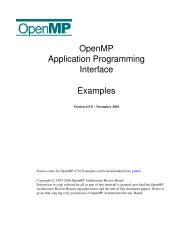D2 3 Computing e-Infrastructure cost calculations and business _models_vam1-final
D2 3 Computing e-Infrastructure cost calculations and business _models_vam1-final
D2 3 Computing e-Infrastructure cost calculations and business _models_vam1-final
You also want an ePaper? Increase the reach of your titles
YUMPU automatically turns print PDFs into web optimized ePapers that Google loves.
e-‐FISCAL: www.efiscal.eu <br />
EC Contract Number: 283449 <br />
5.3 e-FISCAL sample <strong>and</strong> main findings<br />
e-‐FISCAL received 28 high quality answers from 16 countries which constitute a diverge sample from different <br />
types of centres in terms of size (small <strong>and</strong> large), in terms of nature (HPC <strong>and</strong> HTC), with a low or high number of <br />
staff, etc. e-‐FISCAL was able to calculate several metrics, including <strong>cost</strong> per core hour, CAPEX/OPEX ratio, <br />
depreciation rates, <strong>cost</strong> distribution, electricity PUE. The main findings can be summarised as follows: <br />
• Cost effectiveness: In-‐house HPC/HTC e-‐<strong>Infrastructure</strong>s are <strong>cost</strong>-‐effective with the high average utilisation <br />
rates (65-‐75%) <strong>and</strong> depreciation rates (5 years) recorded. However, per application <strong>cost</strong> analysis is needed <br />
<strong>and</strong> e-‐FISCAL did not have the resources to execute several comparative application case studies. <br />
• Cost structure: OPEX dominates the <strong>cost</strong>s (around 70%) – Personnel <strong>cost</strong>s are around half of the total <strong>cost</strong>s, <br />
while personnel <strong>cost</strong>s vary a lot around Europe. <br />
• Comparison with state of the art: The e-‐FISCAL findings are in-‐line with the results of similar studies identified <br />
in the state of the art through literature review. <br />
• HPC-‐ HTC comparison: It appears that the HPC sites of the e-‐FISCAL sample (national Tier-‐1 centres) are in <br />
average cheaper than corresponding HTC ones. Possible reasons for this are the higher number of cores per <br />
CPU, the state of the art energy systems, <strong>and</strong> the fact that larger sites have in most cases less FTEs per core. <br />
• Cost on the basis of size (no of cores) -‐ Big vs. small sites: It appears that sites with 1000 cores. Indicative values for <strong>cost</strong> per core hour are around € 0.09 for the first <br />
category <strong>and</strong> € 0.05 for the latter. <br />
• Cost structure heterogeneity: there is heterogeneity in the <strong>cost</strong> structure of sites/centres (in terms of <strong>cost</strong> <br />
categories). However, it is rather evident that in the vast majority of cases OPEX is not less than 40% of total <br />
<strong>cost</strong>s <strong>and</strong> in the average case OPEX dominates <strong>cost</strong>s. <br />
• In-‐house HTC <strong>and</strong> HPC vs. commercial Clouds; Benchmarking: Cloud service providers usually have a wide <br />
portfolio of instances <strong>and</strong> services. <br />
o Comparisons between in-‐house <strong>and</strong> commercial clouds have to be made very carefully, trying to <br />
compare like with like. Benchmarking is thus very relevant in this exercise as it identifies comparable <br />
performances between in-‐house configurations <strong>and</strong> cloud instances, especially because the cloud <br />
instance description might not always be easily comparable. <br />
o Performance degradation of cloud virtual machines with the in-‐house e-‐<strong>Infrastructure</strong> have to be <br />
accounted for through appropriate weight factors, especially in cases where virtual machines are <br />
compared to bare metal. <br />
o With the small-‐scale benchmarking exercise a 27% <strong>and</strong> 43% degradation has been averaged for HTC <br />
<strong>and</strong> HPC respectively. <br />
o Taking these degradations into account <strong>and</strong> comparing Amazon EC2 with the e-‐FISCAL HTC <strong>and</strong> HPC <br />
<strong>cost</strong>s, it is obvious that: <br />
Amazon st<strong>and</strong>ard reserved instance prices are comparable with e-‐FISCAL ones <strong>and</strong> sometimes <br />
cheaper (the 3-‐year reserved ones) <br />
Amazon st<strong>and</strong>ard On-‐dem<strong>and</strong> ones are always more expensive than e-‐FISCAL <br />
Amazon cluster compute ones (HPC in the cloud) are always much more expensive (1.5 to <br />
around 5 times) <br />
• Several disclaimers have to be taken into account though as analysed in the previous <br />
section such as comparing 2012-‐2013 prices with 2011 <strong>cost</strong>s, the exclusion of <br />
e-‐FISCAL : Financial Study for Sustainable <strong>Computing</strong> e-‐<strong>Infrastructure</strong>s <br />
Deliverable <strong>D2</strong>.3 – <strong>Computing</strong> e-‐<strong>Infrastructure</strong>s <strong>cost</strong> estimation <strong>and</strong> analysis – Pricing <strong>and</strong> <br />
Business <strong>models</strong> <br />
71




